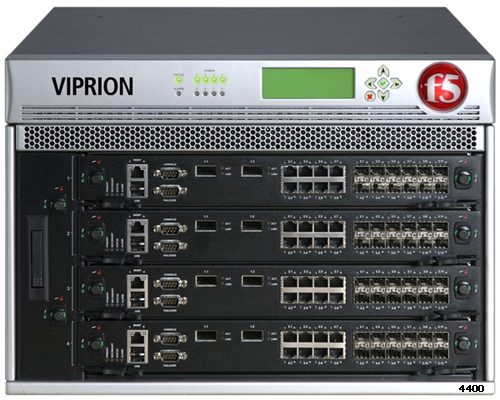Applies To:
Show Versions
BIG-IP APM
- 11.6.5, 11.6.4, 11.6.3, 11.6.2, 11.6.1, 11.5.10, 11.5.9, 11.5.8, 11.5.7, 11.5.6, 11.5.5, 11.5.4, 11.5.3, 11.5.2, 11.5.1
BIG-IP GTM
- 11.6.5, 11.6.4, 11.6.3, 11.6.2, 11.6.1, 11.5.10, 11.5.9, 11.5.8, 11.5.7, 11.5.6, 11.5.5, 11.5.4, 11.5.3, 11.5.2, 11.5.1
BIG-IP LTM
- 11.6.5, 11.6.4, 11.6.3, 11.6.2, 11.6.1, 11.5.10, 11.5.9, 11.5.8, 11.5.7, 11.5.6, 11.5.5, 11.5.4, 11.5.3, 11.5.2, 11.5.1
BIG-IP AFM
- 11.6.5, 11.6.4, 11.6.3, 11.6.2, 11.6.1, 11.5.10, 11.5.9, 11.5.8, 11.5.7, 11.5.6, 11.5.5, 11.5.4, 11.5.3, 11.5.2, 11.5.1
BIG-IP ASM
- 11.6.5, 11.6.4, 11.6.3, 11.6.2, 11.6.1, 11.5.10, 11.5.9, 11.5.8, 11.5.7, 11.5.6, 11.5.5, 11.5.4, 11.5.3, 11.5.2, 11.5.1
VIPRION overview
The VIPRION system is a complete traffic management solution that offers high performance, reliability, scalability, and ease of management. Based on chassis and blade technology, this system is designed to meet the needs of large, enterprise networking environments that normally require multiple BIG-IP systems to process large volumes of application traffic.
The VIPRION system consists of a chassis with a four-blade capacity. The four blades work together as a powerful system to process application traffic. Traffic comes into a single virtual server, and the system distributes that traffic over multiple blades, using the full multi-processing capacity of each blade. Moreover, if a blade unexpectedly becomes unavailable, another blade can complete the processing of the request.

VIPRION features
This table describes the VIPRION® system features.
| Feature | Description |
|---|---|
| A chassis with blades | The multi-slot chassis significantly reduces the amount of rack space required for the BIG-IP® systems by housing blades instead of traditional switch systems. Hardware resources such as cooling and power systems, normally required for individual BIG-IP systems, are now part of the chassis instead. |
| Cluster technology | The VIPRION system's SuperVIP™ cluster technology is the core feature that coordinates all of the blades into a single high-performance system. A SuperVIP cluster is the group of slots in the VIPRION system chassis. Each slot in the cluster represents a cluster member, and any blades that you insert into the slots of a cluster work together to process application traffic. Cluster technology provides the processing power of multiple blades, but you manage the entire cluster as a single system. |
| Live installation | When you upgrade the BIG-IP software on a running system, the system automatically upgrades the BIG-IP software on all blades in the cluster. |
| Cluster synchronization | The primary blade automatically propagates the system configuration to all secondary blades, even when a new blade is introduced into the cluster. |
| Connection mirroring | Connection mirroring ensures that if a blade, or a cluster within a device service clustering (redundant system) configuration, becomes unavailable, the system can still process any existing connections. |
Related documents
You may find it useful to have an understanding of certain background concepts before performing VIPRION® configuration tasks.
- For more information about configuring required BIG-IP® network objects (trunks, VLANs, and self IP addresses), refer to the BIG-IP® TMOS®: Concepts Guide.
- For more information about configuring the BIG-IP system (or vCMP® guests) to manage local area network traffic (concepts pertaining to virtual servers, various types of traffic profiles, load balancing pools and pool members, and so on) refer to the BIG-IP® Local Traffic Manager: Concepts Guide.
These product guides are available from the AskF5 Knowledge Base web site, http://support.f5.com.





